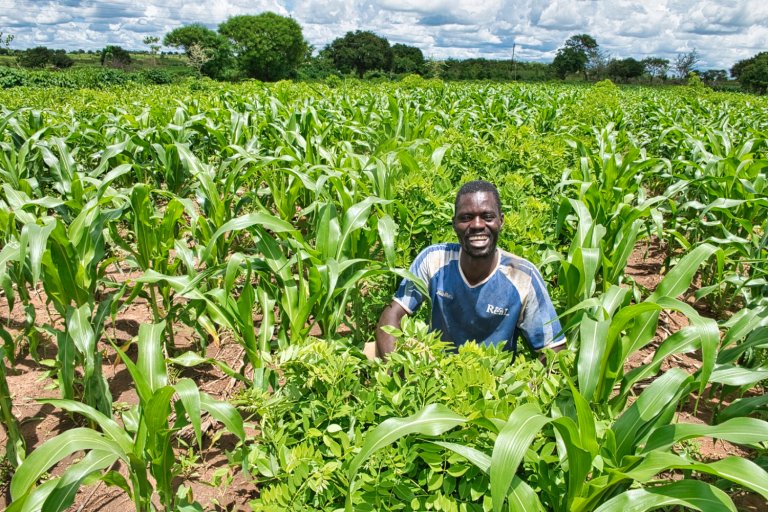Gliricidia intercropping in Zambia shows promising results

As a component of agroforestry, both soil health and crop nutrition can be improved by incorporating Gliricidia leaf manure, like these farmers are doing. Photo: Mr. Bernard Ndege
Combining conservation practices with Gliricidia treatment is proving positive for both nutrition and soil health on maize, soybean, and groundnut trial plots in Zambia.
The species Gliricidia sepium is a deciduous tree, cultivated and used for a variety of purposes in tropical regions. In Zambia, it is used for timber, firewood, medicine, charcoal, living fences, and plantation shading. Not only that, as a component of agroforestry, both soil health and crop nutrition can be improved by the incorporation of the leguminous tree’s leaf biomass.
In 2019, a joint research effort for demonstrating and documenting the effects of Gliricidia in different farming systems in Zambia was established. The emphasis of the NIBIO-coordinated project is to do in-depth analysis on the potential yield gains in maize-legume cropping systems using Gliricidia, and to add to existing knowledge generated from previous research.
The project is now in its third year, and so far, the results are promising. Among other things, Gliricidia intercropping has proved to significantly reduce the tannin and phytic contents in soybeans, groundnuts, and maize grains. In addition, Gliricidia has increased the nitrogen content in grains, thereby increasing their protein content.

Field trials with crop and soil analyses from 15 sites
In the project, field trials with seven treatments at 15 sites in Zambia have been established. One of the treatments tested has included Gliricidia intercropping with maize, soybean, and groundnuts, with sole crops as control trials. Crop and soil samples from all sites have been collected and analysed for, among other things, nutritional properties, mycotoxins and microbial load.
In general, the results show that the treatments with intercropping of Gliricidia provide higher ash, total carbohydrate, starch, amylose, and crude fiber contents than the controls consisting of sole maize. In addition to the increased nitrogen level and reduction of tannin and phytic contents in various crops, improved functional properties have also been observed.
As far as the common mold fungi Aspergillus spp. is concerned, Gliricidia incorporation has had minimal effect on its occurrence and distribution in both soils and crops.
Lower mycotoxin prevalence with Gliricidia treatments
Overall, treatments with Gliricidia have resulted in lower mycotoxin prevalence, while sole maize registered with the highest levels. Gliricidia has also proved beneficial for soil fertility and carbon sequestration, with total organic carbons stocks in soils ranging from 17,6 – 25,6 C t/ha.
“So far, results from the project indicate that correlating available Gliricidia agroforestry technology with soil health can indeed improve crop nutrition,” says Project Coordinator Dr. Udaya Sekhar Nagothu from NIBIO. “This research should help how Zambian small-scale farmers adopting Conservation Agriculture with agroforestry can contribute to healthier, more nutritious food crops.”
This outcome is in line with the Norwegian Government’s priority to invest in areas related to food security and nutrition. The Norwegian Agency for Development Cooperation (NORAD) recently extended its funding of the Gliricidia project period with one year.
Contacts


A joint research effort
Gliricidia Impacts on Soil fertility, Crop yields and Nutrition in Zambia is a joint research effort between NIBIO, COMACO, Zambia, IITA, and ICRAF for documenting the effects of Gliricidia under Conservation Agriculture (CA) in different farming systems in Zambia.
The main objective of the NORAD/MFA funded project is to provide the agency and the scientific community with information on the relevance of continued support to Gliricidia based agroforestry systems under CA – and to assess the potential return rate – in social, economic, environmental and agronomic terms of such systems, as well as potential risk of the farming system for smallholders.

Contacts






